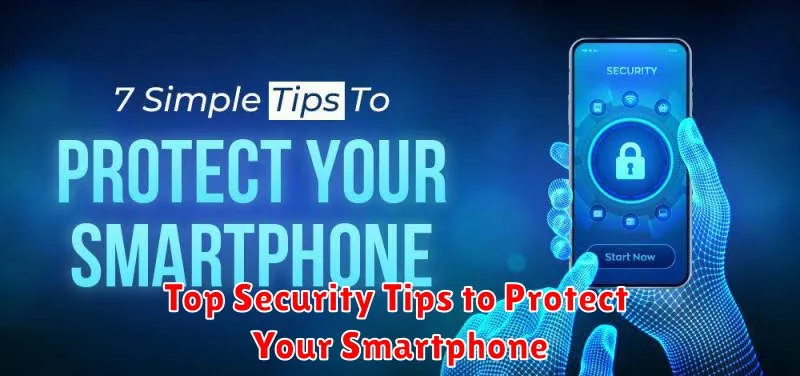In today’s interconnected world, our smartphones have become indispensable tools, serving as gateways to our personal and professional lives. They store a wealth of sensitive information, from private conversations and financial details to confidential work documents and precious memories. This makes smartphone security of paramount importance. Failing to implement robust security measures can leave you vulnerable to a range of threats, including data breaches, identity theft, and financial loss. This article outlines the top security tips you need to implement to effectively protect your smartphone and safeguard your valuable data.
Protecting your smartphone doesn’t have to be complicated. By understanding the potential security risks and adopting a few simple yet effective security practices, you can significantly enhance your smartphone security. From setting a strong passcode to regularly updating your software and being wary of suspicious links, the following top security tips provide a comprehensive guide to securing your device and maintaining your digital privacy. Implement these strategies to keep your data safe and enjoy peace of mind knowing your smartphone is well-protected against emerging threats.
Using a Strong Lock Screen
A strong lock screen is the first line of defense against unauthorized access to your smartphone. Avoid simple patterns or easily guessed PINs. Instead, opt for a strong alphanumeric password or, if available, biometric authentication.
Choosing a Secure Lock Screen Method
There are several lock screen options available, each with varying levels of security:
- Biometrics (Fingerprint, Facial Recognition): Offers the highest level of security and convenience.
- Alphanumeric Password: A complex combination of letters, numbers, and symbols is highly secure.
- PIN: Longer PINs are more secure than shorter ones, but less so than complex passwords.
- Pattern: The least secure option; avoid using predictable patterns.
Enable automatic screen lock after a short period of inactivity to prevent unauthorized access if your phone is left unattended.
Regularly review and update your chosen lock screen method to maintain optimal security.
App Permissions Management

Controlling app permissions is crucial for maintaining your smartphone’s security and privacy. Apps often request access to various features and data on your device, some of which may not be necessary for their core functionality. Granting unnecessary permissions can expose your personal information to risks.
Regularly review and manage the permissions granted to your installed apps. Go through your phone’s settings and look for the app permissions manager. You should see a list of apps and the permissions they’ve been granted, such as access to your camera, microphone, location, contacts, and storage.
For each app, assess whether the requested permissions are justified based on its purpose. Revoke permissions for any access that seems unnecessary or excessive. This practice significantly minimizes the potential for data breaches and unauthorized access.
Enabling Two-Factor Authentication
Two-factor authentication (2FA) adds an extra layer of security to your smartphone by requiring a second verification method in addition to your password. This makes it significantly more difficult for unauthorized individuals to access your device, even if they obtain your password. Enabling 2FA is one of the most effective ways to protect your sensitive data.
Most online accounts and apps offer 2FA. Common methods include receiving a unique code via text message, using an authenticator app, or through biometric verification like fingerprint or facial recognition. When setting up 2FA, you’ll typically be guided through the process within the app or account settings.
While slightly less convenient than relying solely on a password, the increased security provided by 2FA is well worth the minimal extra effort. By enabling 2FA, you significantly reduce the risk of unauthorized access and protect yourself from potential data breaches.
Avoiding Public Wi-Fi
Public Wi-Fi hotspots are convenient, but they pose a significant security risk to your smartphone. These networks are often unsecured, meaning your data is transmitted in plain text, vulnerable to interception by malicious actors.
Hackers can easily eavesdrop on your online activity, stealing sensitive information like passwords, credit card numbers, and personal details. They might even set up fake Wi-Fi hotspots that mimic legitimate ones, tricking you into connecting and handing over your data.
Whenever possible, avoid using public Wi-Fi for activities involving sensitive information. Prioritize using your cellular data connection or wait until you have access to a secure, trusted network.
If you must use public Wi-Fi:
- Verify the network name: Double-check the name with the establishment providing the Wi-Fi.
- Use a VPN: A Virtual Private Network encrypts your data, adding a layer of security.
- Limit sensitive activities: Refrain from online banking, shopping, or accessing confidential information.
Recognizing Phishing Attempts

Phishing attacks target your personal information through deceptive emails, text messages, or websites. These messages often appear legitimate, masquerading as official communications from banks, social media platforms, or online stores. Be wary of any message requesting personal details such as usernames, passwords, credit card numbers, or social security numbers.
Key indicators of a phishing attempt include:
- Suspicious sender addresses: Check the sender’s email address closely. Look for misspellings, unusual characters, or domains that don’t match the claimed organization.
- Generic greetings: Phishing messages often use generic greetings like “Dear Customer” instead of your name.
- Urgent or threatening language: Phishers often create a sense of urgency or fear to pressure you into acting quickly without thinking.
- Requests for personal information: Legitimate organizations rarely request sensitive information via email or text.
- Suspicious links: Hover over links before clicking to see the actual URL. Be cautious of shortened links or URLs that don’t match the claimed website.
If you suspect a phishing attempt, do not click on any links or provide any information. Report the message to the organization it supposedly came from and delete it immediately.

